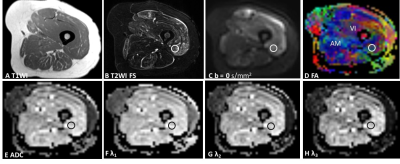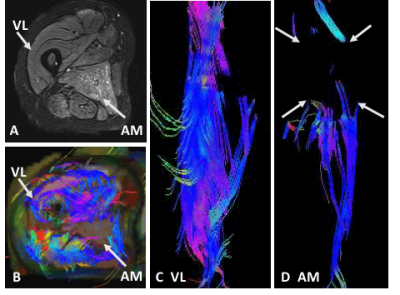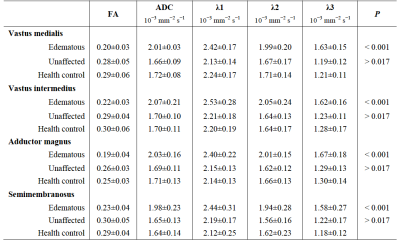1046
Simultaneous Multislice Accelerated Diffusion-Tensor Imaging of Thigh Muscles in Myositis1Radiology, Peking Union Medical College Hospital, Beijing, China, 2Rheumatology, Peking Union Medical College Hospital, Beijing, China, 3Radiology, Shenzhen Sun Yat-Sen Cardiovascular Hospital, Shenzhen, China, 4MR Collaboration NE Asia, Siemens Healthcare, Shanghai, China
Synopsis
We investigated the clinical feasibility of using simultaneous multislice accelerated echo planar imaging diffusion-tensor imaging (SMS-EPI-DTI) to image thigh muscles of both 10 healthy control subjects and 20 dermatomyositis (DM)/ polymyositis (PM) patients. This technique yielded a reduced scan time to only about five minutes. The results showed that the tractographic imaging and DTI-derived parameters of edematous muscles differed among affected and unaffected muscles of the DM/PM patients and normal muscles of the control subjects. In conclusion, SMS-EPI-DTI is clinically feasible for imaging thigh muscles and quantitatively evaluating edematous muscles of DM and PM patients.
Background and Purpose
Dermatomyositis
(DM) and polymyositis (PM) are the two leading types of idiopathic inflammatory
myopathy and both of them have a high morbidity and mortality.[1] The use of
diffusion-tensor imaging (DTI) in thigh muscles for diagnosis and monitor is
technically challenging due to long data acquisition time and motion artifacts.
[2] In this study, we investigated the clinical feasibility of using
simultaneous multislice accelerated echo planar imaging (SMS-EPI)-DTI to image
and analyze the anisotropic diffusion characteristics of the thigh muscles in
DM and PM patients.Materials and Methods
Results
Discussion and Conclusion
SMS is a recent innovation of the MRI technique that accelerates data acquisition through scanning and reconstruction of multiple slices simultaneously, without decreasing the SNR. [3] In this study, the scanning time of the SMS- EPI-DTI sequence for both upper legs from hip to knee was only five minutes in one examination, which is significantly shorter than other DTI techniques of comparable spatial resolution (20–40 min) [4]. For edematous muscles in the DM/PM patients, the tracking fibers and FA values decreased, whereas the ADC values increased, consistent with the pathophysiological changes of DM/PM [5]. In addition, all three eigenvalues were increased in edematous muscles in the DM/PM patients, with the greatest and lowest elevations observed in λ3 (27%–34%) and λ1 (8%–15%), in accordance with a prior animal study using a murine model [6] and other research in myositis patients [7]. In conclusion, SMS-EPI-DTI is clinically feasible for imaging thigh muscles and quantitatively evaluating the edematous muscles of DM and PM patients.
Acknowledgements
The authors thank TianYi Qian (Siemens Healthcare, Beijing, China) for his technical support, Yan Zhang (Department of Radiology, Peking Union Medical College Hospital, Chinese Academy of Medical Sciences & Peking Union Medical College) for instructions in muscle evaluation, and Bo Hou (Department of Radiology, Peking Union Medical College Hospital, Chinese Academy of Medical Sciences & Peking Union Medical College) for scanning data.References
1. Findlay AR, Goyal NA, Mozaffar T. An overview of polymyositis and dermatomyositis. Muscle Nerve. 2015; 51(5):638-656.
2. Damon BM, Buck AK, Ding Z. Diffusion-Tensor MRI Based Skeletal Muscle Fiber Tracking. Imaging Med. 2011, 3(6):675-687.
3. Barth M, Breuer F, Koopmans PJ, et al. Simultaneous multislice (SMS) imaging techniques. Magn Reson Med. 2016; 75(1):63-81.
4. Froeling M, Oudeman J, Strijkers GJ, et al. Muscle changes detected with diffusion-tensor imaging after long-distance running. Radiology. 2015; 274(2):548-562.
5. Carstens PO, Schmidt J. Diagnosis, pathogenesis and treatment of myositis: recent advances. Clin Exp Immunol. 2014; 175(3):349-358.
6. Bryant ND, Li K, Does MD, et al. Multi-parametric MRI characterization of inflammation in murine skeletal muscle. NMR Biomed. 2014; 27(6):716-725.
7. Ai T, Yu K, Gao L, et al. Diffusion tensor imaging in evaluation of thigh muscles in patients with polymyositis and dermatomyositis. Br J Radiol. 2014; 87(1043):20140261.
Figures



